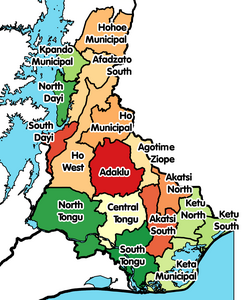Anloga Municipal Aŋlɔga Nutome | |
|---|---|
 Districts of Volta Region | |
Location of Anloga Municipal within Volta | |
| Coordinates: 5°47′13.7″N0°53′25.8″E / 5.787139°N 0.890500°E | |
| Country | |
| Region | |
| Capital | Anloga |
| Government | |
| • Municipal Chief Executive | Hon. Sandra Seyram Kpedor |
| • Awormefia of Anlo State | Togbui Sri III [1] |
| Area | |
• Total | 314 km2 (121 sq mi) |
| Population (2021 [2] ) | |
• Total | 94,895 |
| • Density | 300/km2 (780/sq mi) |
| Time zone | UTC+0 (GMT) |
| Ghana Post GPS | VK |
| Area code | 03626 |
| ISO 3166 code | GH-TV-AL |
Anloga Municipal is one of the eighteen districts in Volta Region, Ghana. Originally it was formerly part of the then-larger Keta District on 10 March 1989, which was created from the former Anlo District Council. However on 19 February 2019, the western part of the district was split off to create Anloga District (which is now Anloga Municipal Assembly) as one of six districts inaugurated by the Akufo-Addo Government, [3] [4] thus the remaining part has been retained as Keta Municipal District . The Municipal assembly is located in the southwest part of the Keta basin in the southern part of the Volta Region and has Anloga, the spiritual, cultural and traditional capital of the Anlo Kingdom as its Municipal capital town.
